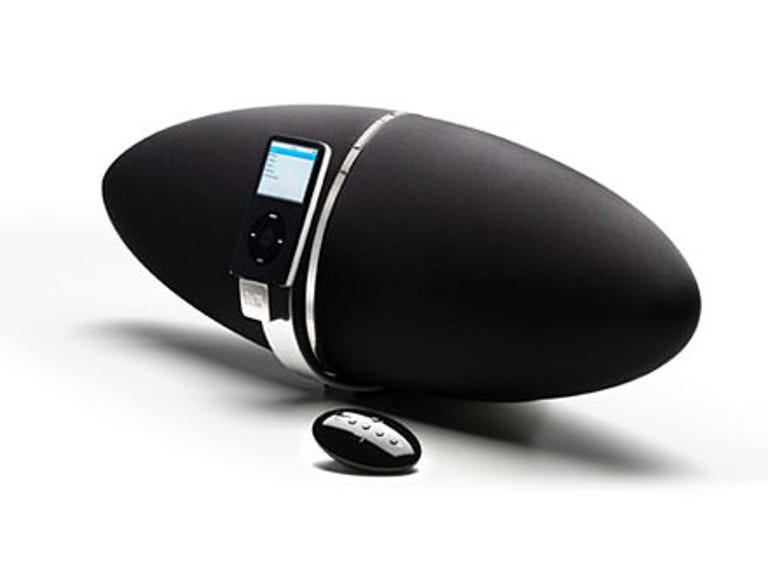 Why You Can Trust CNET
Why You Can Trust CNET B&W Zeppelin iPod speaker review: B&W Zeppelin speaker
B&W has made a grand, sweeping entrance into the lucrative iPod accessory market with the lush but pricey Zeppelin.
Bowers and Wilkins or B&W is a posh British audio company best known for creating seriously smooth hi-fi equipment. The company produced the speakers that sit inside the Abbey Road studios, so it's fair to say that they're rather good at the old tweeter-and-woofer jive. Now B&W has made a grand, sweeping entrance into the lucrative iPod accessory market with the Zeppelin, a lovingly crafted speaker that retails for a slightly shocking AU$999.95.
The Good
The Bad
The Bottom Line
Design
Dirigible, elongated football, a tipped-over eye of Sauron — the Zeppelin is sort of like a Rorschach inkblot test in that the way you describe its ovoid shape reflects your own psychology. The designers at B&W were obviously inspired by German airships when drawing up the blueprints, though the decision to align a top-of-the-line audio device with a dirigible fated for disaster is bold to say the least.
Regardless of how you interpret the Zeppelin's form factor, it's a look that will draw attention in any lounge room. The black-clad speaker is sleek and imposing, its heft and lack of buttons adding up to one fine-lookin' piece of audio.
The design of the dock connection is quite nifty; instead of being a rigid dock that traps your iPod between the speakers, the Zeppelin has a spring-loaded arm that allows you to hold the player when it's plugged in.
The ovoid remote fits nicely in the palm, but its tiny identical buttons don't display the same level of creativity that went into the main unit. The piano-black finish and mirrored back draw fingerprints, and the compact size means you're liable to lose the remote between the couch cushions if you're not careful.
The other accessory, a rubber, oval-shaped stand, looks like it was shipped with the wrong product, but everything starts to make sense when you attach it to the base of the speaker. The stand changes the angle of sound projection by tilting the speaker up, allowing songs to be projected into a room instead of toward the floor.
Features
Beyond "resemblance to rigid dirigible" and "sonic superiority to every other iPod speaker", the Zeppelin doesn't sport an overwhelming number of features. However, there are enough sockets to keep everyone happy; beneath the gleaming silver of the rear side you've got S-Video and composite video outputs, so you can hook the Zeppelin up to your telly. There are also analogue and optical audio inputs for plugging in other music sources.
Performance
We tested the Zeppelin with a range of songs, from skanky 128-kilobit MP3s to full-flavoured Apple lossless files. Each song confirmed initial suspicions: the Zeppelin is the best-sounding iPod speaker we've encountered. Nick Cave and the Bad Seeds' Red Right Hand — a song that highlights the limitations of most speaker docks and hi-fi systems — was richly detailed, the bass-heavy instrumentation clearly distinct from Cave's similarly pitched vocals. The ratchet-like scraping sound of a guiro during the mid-song interlude was particularly nicely reproduced, emerging from the background with spine-tingling effect.
All up, the Zeppelin sounded more like a set of hi-fi speakers than the majority of reverb-heavy iPod docks that have inhabited our test room. For the ultimate comparison, we tested the Zeppelin against B&W's own CM1 speakers. While they weren't too far off in terms of audio definition, the main difference was the width of the sound. Understandably, the 64cm-wide Zeppelin can't quite compete against the CM1s when it comes to full-bodied, room-filling stereo sound.
Just for kicks, we also went the other way and pitted the Zeppelin against an aging yet plucky Altec Lansing inMotion 7 dock. The comparatively tinny, muddied audio emanating from the Altec Lansing model highlighted the Zeppelin's refinement, as did the older product's inability to handle bass at upper volumes without resorting to distracting reverberation.
Compared to other iPod docks we've tested, the Zeppelin sounds fantastic. Songs are rich, full and meaty, but our credit card-grabbing hand is slowed a little by the fact that it does cost a thousand dollars. Still, if you charge your friends an entry fee every time you have a party, the Zeppelin will quickly pay for itself.


